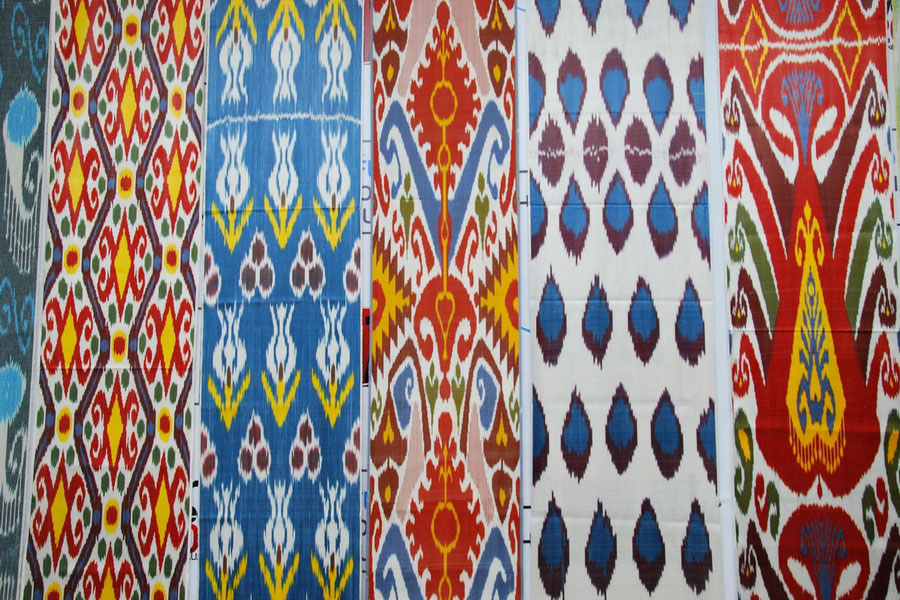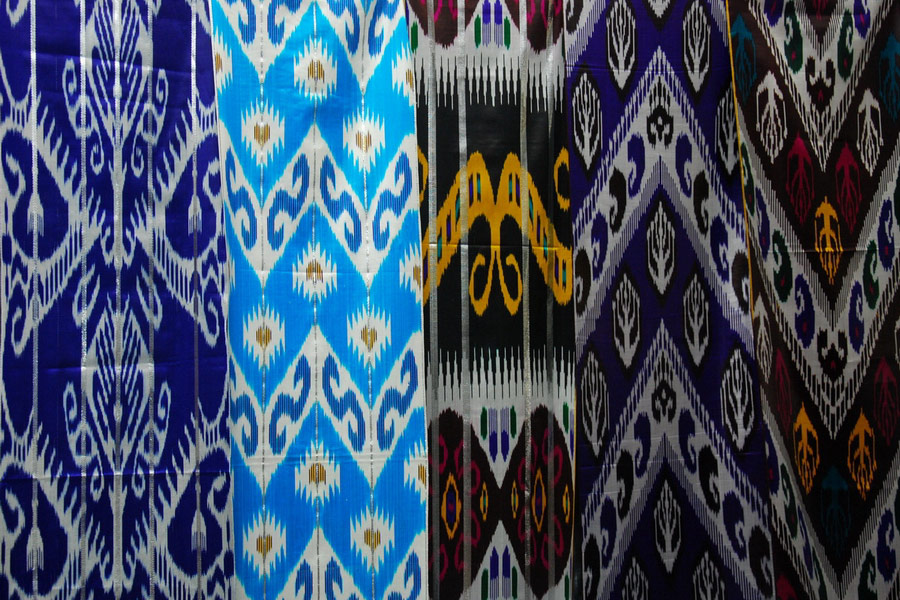
Uzbek textiles are more than functional materials – they are bearers of cultural memory, aesthetic philosophy, and symbolic meaning. Their patterns echo the natural environment, social structure, and belief systems shaped over centuries. Silk and cotton, colored with natural dyes, form the basis of a distinctive textile tradition that continues to this day. Masters still employ time-honored techniques, translating the visual language of the historic East – vivid, refined, and resonant – into contemporary form.
Uzbek textiles are more than everyday materials – they are vessels of history, culture, and meaning. Woven patterns capture echoes of the natural world, social customs, belief systems, and aesthetic ideals shaped over centuries. Silk and cotton dyed with natural pigments form the foundation of a textile tradition that endures to this day. Craftsmen continue to work with age-old techniques, translating the colors and textures of the historic East into the language of contemporary design – vivid, elegant, and deeply rooted.
Main Types of Uzbek Textiles
Uzbekistan is widely recognized as one of the world’s centers of traditional textile production. Both utilitarian cotton weaves, suited for daily wear, and vivid silk fabrics, long associated with celebration, elegance, and cultural symbolism, continue to be produced here. Among the most renowned are bekasam, adras, and atlas – each distinguished by its unique texture, color palette, and function. Though differing in form and use, these fabrics are united by their exceptional quality and adherence to centuries-old weaving traditions.
Cotton Fabrics
Cotton has long occupied a central role in both the daily life and economy of Uzbekistan. The country is among the world’s leading producers, harvesting approximately 3.5 million tons of raw cotton each year, from which hundreds of thousands of tons of fiber are derived. While a portion of this yield is exported, much of it supplies domestic textile factories, sustaining a vibrant tradition of cotton-based production.
One of the most distinctive Uzbek cotton fabrics is bekasam, known for its dense weave, matte finish, and signature vertical stripes – motifs traditionally associated with order, balance, and forward motion. Historically used for men’s robes, bekasam is now widely embraced in contemporary fashion, appearing in jackets, dresses, vests, and even interior design elements.
Bekasam may be woven from pure cotton or blended with silk, depending on the intended use and the artisan’s preferences. In every form, it remains a durable, expressive, and culturally resonant fabric – valued for its balance of functionality and symbolic depth.
Silk Fabrics
Alongside cotton, silk stands as one of the defining symbols of Uzbekistan’s textile heritage. The country ranks just behind China and India in natural silk production, and its centuries-old traditions of sericulture and hand-weaving have been officially recognized by UNESCO as part of the Intangible Cultural Heritage of Humanity.
For generations, silk was far more than a trade good – it became the foundation of one of the most significant commercial routes in history: the Silk Road. Central Asia, and particularly the territory of present-day Uzbekistan, played a crucial role in supplying highly sought-after textiles to both Eastern and European markets.
Silk fabrics were long considered a luxury reserved for rulers and the elite. Ancient sources, including Roman authors, described how gold flowed eastward in exchange for these exquisite materials. Their value lay in a combination of qualities – remarkable softness, lightness, luster, rich coloration, and exceptional durability.
Among the most celebrated Uzbek silk fabrics are atlas and adras. Atlas, woven entirely from silk threads, is smooth, glossy, and traditionally associated with festive attire. Adras, by contrast, combines silk and cotton threads in roughly equal proportions, giving it a more muted texture while retaining elegance. Both are widely used in traditional and modern garments –robes, dresses, scarves – as well as in ornamental applications.
Silk fabrics also hold a special place in interior design. They are used to create pillows, bedspreads, curtains, and even carpets, enhancing both ceremonial settings and everyday living spaces – particularly in homes where cultural traditions remain strong.
Silk Fabric Production in Uzbekistan

Silk production originated in China over eight thousand years ago, and on the territory of present-day Uzbekistan it has been known for at least four millennia. Remarkably, the core techniques have remained largely unchanged. Traditional workshops across the country continue to rely on a time-honored, labor-intensive process passed down through generations.
The complete production cycle includes up to twelve distinct stages. It begins with the cultivation of silkworms – caterpillars that feed exclusively on mulberry leaves. After about a month of growth, the silkworms spin cocoons over the course of several days. Each cocoon yields up to two kilometers of ultrafine silk filament. To produce a thread suitable for weaving, between five and thirty filaments are combined.
Following the unwinding of the silk, the next steps are dyeing and weaving. In Uzbekistan, traditional hand looms based on ancient designs are still widely used. This explains why many Uzbek silk fabrics are relatively narrow, typically measuring around 40 centimeters in width.
Natural dyes remain an important part of the process. Historically, colorants were derived from materials such as onion skins, madder root, walnut shells, and indigo. While modern workshops may also use synthetic aniline dyes – favored for their low cost and uniformity – natural dyes continue to be prized for their depth, nuance, and rich tonal variations.
Ikat: An Uzbek Technique with a Global Reputation
Among all types of Uzbek textiles, ikat holds a distinct place – a weaving technique in which the pattern is created before the fabric itself is formed. Recognizable by its characteristic soft-edged designs, ikat stands out at first glance. This ancient method continues to inspire designers worldwide, including Giorgio Armani, who based his 2020 Ikat Luxe collection on the technique, enhancing its layered effect to evoke the impression of a pattern hidden within the fabric’s depth.
The core of ikat lies in the pre-dyeing of threads. Before weaving begins, specific segments of the threads are tightly bound to resist dye and then colored in successive stages. Once the bindings are removed, a multicolored pattern appears, which is then “assembled” on the loom. This process gives the motifs their signature blurred appearance – shapes that seem to dissolve into the fabric’s texture. In Uzbekistan, these textiles are known as abro, a term derived from abr, meaning “cloud.”
Ikat is often compared to batik, yet the two differ in method. In batik, designs are applied to finished cloth, resulting in crisp, defined patterns. In ikat, by contrast, the pattern is embedded in the threads themselves, yielding a softer, more fluid effect.
The motifs of Uzbek ikat are traditionally drawn from nature and cultural symbolism. Patterns may include clouds, trees, pomegranates, almonds, or abstract representations of protective amulets, women’s jewelry, and animals such as scorpions.
Among the most iconic abr textiles is khan-atlas, woven entirely from silk. According to legend, a poor weaver created the fabric to dissuade the ruler of Margilan from marrying his daughter. Moved by the cloth’s iridescent beauty – resembling the sky after rain – the khan released the girl, and khan-atlas became a symbol of elegance, creativity, and personal freedom.
Today, khan-atlas remains a popular choice for festive occasions such as weddings, holidays, and cultural celebrations. Its glossy surface, radiant colors, and shifting tones continue to evoke a sense of joy and timeless style.
Where to Buy Uzbek Textiles

Weaving traditions continue to thrive across many cities in Uzbekistan. Notable centers include Bukhara, Samarkand, Namangan, and Kokand – each home to workshops, textile boutiques, and local markets offering handmade cotton and silk fabrics, along with designer garments and accessories crafted from them.
The historical heart of Uzbek textile production, however, is Margilan. Renowned for its fabrics since the days of the Great Silk Road, the city remains a destination for designers, collectors, and travelers seeking the finest examples of atlas and adras.
One of the region’s most important institutions is the Yodgorlik Silk Factory – one of the largest silk enterprises in Central Asia. Here, traditional craftsmanship is preserved at every stage, from silkworm cultivation to dyeing and weaving. A variety of looms, both antique and modern, are used to produce a wide range of fabrics. The factory welcomes visitors with guided tours, offering an immersive introduction to each stage of production and a rare opportunity to witness living textile heritage.
Margilan is also known for its artisan families, many of whom operate independently or through the Craft Development Center. In 2017, UNESCO recognized the Center’s work by including Margilan’s practices of atlas and adras production in its Register of Good Safeguarding Practices for Intangible Cultural Heritage.
Visitors to the Center and private ateliers can not only purchase fabric but also engage directly with master weavers, observe their process, and ask questions. Among contemporary artisans, Nurmuhammad Valiev stands out – his works are featured both in Uzbekistan and on international platforms, including NOVICA.

